Sit-and-spin robots are one of two forms of thwackbot to appear in Robot Wars. They work under the same principle as a full-body spinner, in that the entire robot is designed to act as a heavy spinning object which makes contact over a small surface area.
Series 2 competitor Spin Doctor was the first robot to employ a sit-and-spin design - the most notable and successful in Robot Wars history include Series 10 joint-third place finisher Nuts 2, Series 6-7 Semi-Finalist Dantomkia (although it mainly relied on its rear-hinged flipper to succeed) and Dutch Series 1 runner-up Lizzard.
Definition
- Sit-and-spin refers to any robot whose only method of attack is to spin on its own axis in hope of damaging opponents when they drive close to it. Most sit-and-spin robots were armed with a sharp or blunt weapon along their ends or edges to facilitate damage, while others featured a circular body with spikes, blades or sharp edges along its sides.
Meltybrain
- "A "Meltybrain" controller works by measuring how fast the robot is spinning, and then stopping each motor for a section of the rotation. Repeating this over and over causes the robot to move forward whilst spinning. By having the drive system power the weapon as well, it reduced the cost and made the robot more reliable by having fewer moving parts."
- — Rory Mangles explains the Meltybrain concept in Robot Wars: Build Your Own Robot
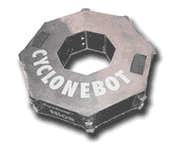
Cyclone, the US pioneer of Meltybrain technology
The sit-and-spin concept waned in popularity as more advanced and effective spinning weapons became more commonplace. During Robot Wars' hiatus, however, a builder in the US discovered and developed a control system which allowed sit-and-spin robots to move and spin at the same time. This technology, dubbed Meltybrain, involves equipping a sit-and-spin robot with LEDs and a motion detection system, enabling the robot to calculate its rotational speed and move across the arena in a controlled manner while spinning. The Meltybrain concept would not be utilised by a Robot Wars competitor until Nuts 2 in Series 10, with outstanding success.
Advantages and Disadvantages
Advantages
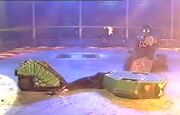
Lizzard uses its tail and sit-and-spin tactics to attack Project Two: Hex'em
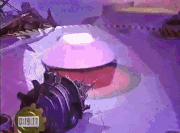
Spin Doctor's design enabled it to break off one of Matilda's tusks and prevent her from pushing it
- Since the sit-and-spin design works under the same principles as those of full-body spinners, robots built this way could theoretically be as damaging as the latter weapon type. A notably effective sit-and-spin robot is inaugural Dutch Robot Wars runner-up, Lizzard, which used its tail to severely damage Neater's lifting forks during their Heat Final in the second series.
- The damage potential of a sit-and-spin design can be greatly increased with Meltybrain technology. With this installed, Nuts 2 was able to damage Concussion's wheels and side panels, rupture Androne 4000's hydraulic lines and break Carbide's weapon chain with its flails during its Series 10 run.
- The sit-and-spin design provides a great degree of protection from various attacks - including ramming - since such attacks will often result in opponents being deflected away upon contact. This was best shown in Spin Doctor's performance in the Series 2 King of the Castle Trial, where its shape and sit-and-spin tactics consistently prevented Matilda from being able to push it off the platform.
- Due to a sit-and-spin robot requiring no powered weaponry, robots of this nature were very easy to produce, and some robots such as Dantomkia could resort to sit-and-spin tactics if they could not rely on their primary, powered weapons.
Disadvantages

Carbide removes Nuts' rotating ring
- While it can be effective at damaging other robots in its range, a conventional sit-and-spin robot cannot usually move and attack at the same time; to attack, it must spin on the spot.
- Spinning in place is not considered to be an aggressive tactic, a factor which can count against a conventional sit-and-spin robot in the event of a Judges' decision.
- Both of these problems can be rectified with a Meltybrain. However, heavyweights generally do not use this technology, and Nuts 2's Meltybrain was very slow due to poor traction on the floor.
- Spinning in place is not considered to be an aggressive tactic, a factor which can count against a conventional sit-and-spin robot in the event of a Judges' decision.
- If a sit-and-spin robot loses drive to one or more wheels on either side through any method, both its locomotion and main weapon will become incapacitated, as the robot relies purely on its drive system to attack. Nuts 2, for example, was unable to attack at all after one of its drive motors failed seconds into its Series 9 Group Battle.
- Series 7 and the three reboot series implemented a rule which required all robots to possess an active weapon, which sit-and-spin robots would technically violate. Nevertheless, robots such as T-Wrecks and Nuts 2 still qualified for the televised series regardless.
- Certain sit-and-spin robots were necessarily fragile, and their weapons could easily be damaged. This happened most infamously during Nuts' Head-to-Head battles with Carbide and Terrorhurtz in Series 8; in each battle, Nuts' opponents were able to remove the rotating ring, leaving it without any means to damage them in response.
- Nuts 2's ring was broken by Carbide again in the Series 10 Grand Final. However, Team Nuts later stated that the ring was not welded properly, and would not have broken so easily otherwise.
List of Sit-and-Spin Robots

Ajjay
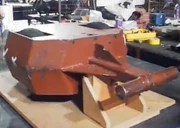
Brawler
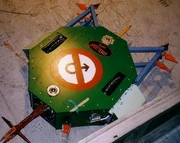
IDO

Lizzard, Dutch Series 1 runner-up
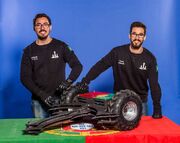
Rabid M8
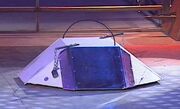
Spin Doctor
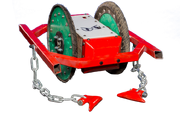
Nuts 2, the only Robot Wars competitor to use Meltybrain technology

The Tartan Terror

T-Wrecks
Robots are listed alphabetically. Robots which are not heavyweight entries are listed with a green background.
| Robot | Series Appearances as Sit-and-Spins | Notes |
|---|---|---|
| Abaddon | Series 3 | Whipping tail, rolled on a castor which had to be changed before combat. |
| Ajjay | Extreme 1 | Was intended to be a full-body spinner, but instead resorted to a sit-and spin tactic. |
| Brawler | US Season 2 | Armed with two static weapons - a diamond-edged spear on one end and a sledgehammer on the other. The robot itself was capable of spinning on the spot at 200rpm, with the intention of hitting opponents as they came into contact with either of its weapons. |
| Coyote | Series 10 | Coyote's 10kg minibot Roadrunner uses a birdlike sit-and-spin design. |
| Crasha Gnasha | Series 3 | Featured a swinging tail concealing a hinged 4lb hammer. |
| Dantomkia | Series 6-8, Extreme 2 | The robot was capable of spinning on the spot at 450rpm (500rpm in Series 8); its front wedges could be used as spikes to damage opponents as its spun round. Limited usage; Dantomkia instead mainly relied on its rear-hinged flipper. |
| Dee | Series 9 | Stock Robot. Effective at both torque reaction and sit-and-spin tactics. Later rebranded as Rabid M8. |
| IDO | Dutch Series 2 | Equipped with a static, horizontally-mounted pickaxe at the rear, used to damage opponents when spinning in place. |
| Impact | Dutch Series 2 | The hammer was covered in fur that was often set alight. |
| Lizzard | Dutch Series 1-2 | A swinging 'swan tail', with cutting blades in Dutch Series 1 and a tip-mounted mace in Dutch Series 2. Dutch Series 1 runner-up, also reaching the Grand Final in Dutch Series 2. |
| Micro-Mute | Extreme 2, Series 7 | Relied more on its speed and wedge shape to win battles. |
| Mini-Maul | Series 7 | Suffered the quickest featherweight immobilisation on the show. |
| Nuts | Series 8-10 | Outside ring originally turned vertically independently, giving the robot a moving weapon. The ring is fitted with chain flails which are designed to swing outwards and hit opponents. Returned to Series 9 as Nuts 2, with planned Meltybrain technology and interchangeable rings, with the Meltybrain technology utilised in Series 10. Third place finisher in Series 10. |
| Rabid M8 | Series 10 | A loanerbot which previously competed as Dee. Effective at both sit-and-spin and torque reaction tactics. |
| Spin Doctor | Series 2 | First Sit-and-Spin design. Managed to rip off one of Matilda's tusks. |
| Stinger | Series 3-6, Extreme 1-2, US Season 1 | Primarily a Torque reaction thwackbot, but would also sit-and-spin as an alternative method of attack. |
| Stomp | Series 3 | Walking robot, used its large box legs as weapons when spinning. |
| T-Wrecks | Series 7 | The only heavyweight robot in Series 7 not to feature an active weapon. |
| The Swarm | Series 10 | One part of the four-part clusterbot, Skye, features a six-spoke 'windmill' structure with tyre sections. The structure is used to hit opponents when the robot spins, and has entanglement features. |
| The Tartan Terror | Series 5 | Armed with a horizontally-mounted ice pick mounted to the robot's base. |
| Wizard | Series 2 | Equipped with a set of chain flails with drill bit tips. |
| ||||||||||||||||||||||||||||||||
